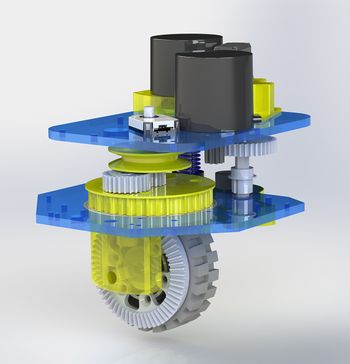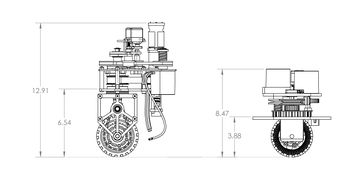Difference between revisions of "DEWBOT XVI Drive-Train"
MaiKangWei (talk | contribs) (→Drive Transmission) |
MaiKangWei (talk | contribs) (→Drive Transmission) |
||
| Line 20: | Line 20: | ||
#) A 15T bevel gear driving a 60T bevel gear bolted to a 4" diameter wheel - 4:1 reduction | #) A 15T bevel gear driving a 60T bevel gear bolted to a 4" diameter wheel - 4:1 reduction | ||
| − | Overall reduction range is 12.33:1 to 6.16:1. | + | Overall drive reduction range is 12.33:1 to 6.16:1. |
We discovered that NEO motors demand steel gears. First used printed plastic spur gears and then 7074 AL spur gears in the drive transmission and these were both chewed up in short order. Bevel gears were always steel. | We discovered that NEO motors demand steel gears. First used printed plastic spur gears and then 7074 AL spur gears in the drive transmission and these were both chewed up in short order. Bevel gears were always steel. | ||
Revision as of 22:26, 16 February 2022
Our 2020 Swerve modules are redesigned from the ground up. Key benefits are reduced mass, low profiles and improved reliability of the Continuously Variable Transmission (CVT) drive. This is the output of a team development project conducted over the past two years.A major change is in the CVT reduction is achieved. The same CVT pulley is used as in previous models, but in lieu using a pair of servo-driven "pinch pulleys" which tension the CVT's V-belt in order to affect change in reduction (by spreading the CVT pulley halves), the C-C distance of the CVT belt loop axles is changed by shifting the position of the drive motor/CVT pulley axle. This position shift is driven by a servo. The "pinch pulley" mechanism was fragile and subject to failure.
The height of the module was significantly reduced. Attachment points to the chassis were also lowered: from 6.54 inches to 3-7/8 inches. This last point allows for a lower chassis frame and improves center of mass. The reduction in overall module height clears space in the robot corners for scoring mechanisms.The shorter swerve modules are also better protected by the robot's bumpers.
During the COVID-19 interregnum, further development was done on the basic design, including a conversion from CVT back to fixed gearing.
Contents
Power Plants
In the original 2929 design, NEO motors were used for both Drive and Steering. In 2021, Steering power was changed to a NEO 550.
Drive Transmission
The 2020 drive transmission comprised:
- ) A nominally 0.9375" - 1.875" diameter CVT pulley driving a 2" diameter pulley via a v-belt - 2.03:1 to 1.07:1 reduction
- ) An 18T spur gear driving a 26T spur gear (20 DP; 14° contact angle) - 1.44:1 reduction
- ) A 15T bevel gear driving a 60T bevel gear bolted to a 4" diameter wheel - 4:1 reduction
Overall drive reduction range is 12.33:1 to 6.16:1.
We discovered that NEO motors demand steel gears. First used printed plastic spur gears and then 7074 AL spur gears in the drive transmission and these were both chewed up in short order. Bevel gears were always steel.

